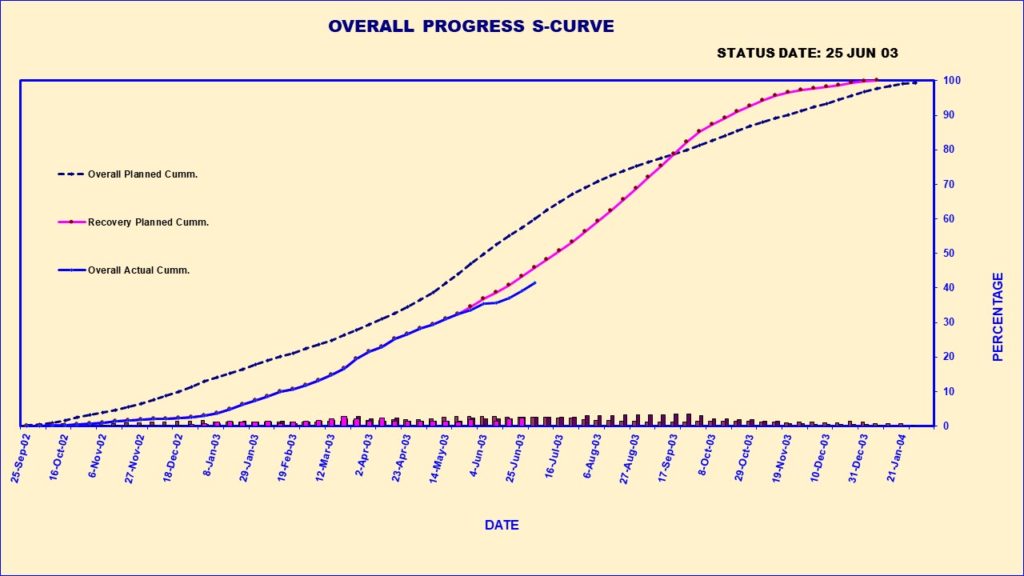HOW TO PREPARE A RECOVERY PLAN THAT WORKS: A STEP-BY-STEP APPROACH

In the last essay I explained the difference between Recovery Plan and Revised Plan. I also explained what a Project Baseline Plan or Schedule is. Finally, I promised to walk you through the process of preparing a recovery plan that works – that recovers the project. In this essay I intend to show you how to prepare a recovery plan that works using a step-by-step approach.
As I explained in that post, the purpose of a Recovery Plan (RP) is to bring project performance back on track to ensure that the contract or milestone completion dates are maintained. Therefore, a RP works when it achieves that purpose.
Now let us go through the process.
Step 1 – Determine a Cut-off Date
This is particularly important because it is the point from which you are going to look forward and backwards. It is the reference point from which you determine project performance – the reference from which we say, for example, “as at this date (1st October 2020, for example) the project is 25% behind schedule.
Step 2 – Determine Work Quantities Remaining
This is not just the percentage of work remaining to be completed but actual work quantities – Dia-Inch of piping, meters of cables, cubic meters of concrete, tonnage of steel, square meters to be painted, etc. This is necessary for determination of resource requirement.
Step 3 – Identify Delayed Activities
This is very straightforward: identify all project tasks that are behind schedule. This includes all tasks, not just critical or critical path activities. This is where project professionals make mistakes – they focus only on critical path activities. They forget that all project tasks, once their floats are consumed become critical and delay the project. The only tasks to leave out are the ones that will not affect project completion date.
Yes, include the proverbial ‘little foxes’ that spoil the vine. This is a comprehensive schedule review. I agree that some activities may be delayed because of knock-on effect from other activities. Take note of those as well.
Step 4 – Investigate, Identify and Document Root Causes
This is one of the most important steps in the process of preparing a recovery plan. I would recommend that senior people who have authority and ultimate responsibility to take decisions be in the room for this step and the next.
I also recommend making this a joint exercise between owner and contractor teams, preferably in the contractor’s facilities. You will soon see why.
You may use any of the root cause analysis methods that you are comfortable with. But simply using the 5-Why Questioning Technique may be sufficient. As Leonardo Da Vinci says, “Simplicity is the ultimate sophistication”. Keep it simple. The purpose is the result not the fancy process.
For example, if the manufacture of a major equipment is delayed, it is not enough to report vendor delay. Ask why the vendor is delayed. You may find out that it is caused by delayed engineering deliverables. That may in turn reveal that engineering is delayed because of dispute over applicable code or standard. Then we have arrived at the root cause of equipment delay.
Step 5 – Establish Recovery Measures
As mentioned in the case above, the person with ultimate authority to decide the applicable standard needs to be in the room and give the direction to follow. That should be documented against the delayed item as recovery measure.
If a project activity is delayed because the specialist has not been mobilized by Human Resources, then the person who needs to make the decision must be in the room to give his word.
The same applies to procurement of equipment and every other issue that has caused the delay.
But, in most cases this is not done. The project team just sits around a table and postulates imaginary dates and solutions. Worse still, the planning engineer is instructed to come up with a recovery plan but he has no authority to compel anyone to act. I have seen even more ridiculous cases where the client planning engineer is required to make a recovery plan for the project executed by a contractor. Terrible!
The Special Case of Productivity
Productivity is often the cause of many project delays. This requires special attention. The review process must compare actual resource deployment against the plan. Has the number and quality of resources assumed in the plan been deployed?
For example, if a concreting work has fallen behind schedule, you need to ask not just about the number of concrete mixers deployed against plan. You also need to ask if the capacities of the mixers deployed were same as planned. For instance, if the plan was based on 5 mixers of 10 cubic meters per hour, it must be established that this is what was deployed.
Again, even when the planned mixer capacity was deployed, you still need to find out if the mixers were delivering according to plan.
The same applies to human resources. Don’t just ask about the number and craft; investigate the competency levels and productivity also.
After answering all the questions mentioned above and similar, then you are ready to prepare the recovery plan.
Step 6 – Develop Recovery Plan
Armed with the result of above investigation: work quantities, dates of resolution of issues, delivery of equipment, decisions, etc. you are now ready to put together a recovery plan.
But you need to resolve the following additional issues before you proceed:
- Will resolution of above issues alone bring the project back on track? If not, what additional steps need to be taken?
- Will deploying resources as originally planned, if this was the cause of delay, bring about recovery? If not, how much additional resources must be deployed? Therefore, those responsible for those decisions need to be in the room.
- Is there need for overtime? How much and how long, taking overtime fatigue into account?
These are the inputs that you use to build a recovery program. This is now the work of the planning engineer – to revise the project program using these inputs.
As you can see, the software aspect of the exercise comes at the end.
This is how to prepare a recovery plan that recovers the project. Otherwise, it would be a futile exercise as is often the case.


